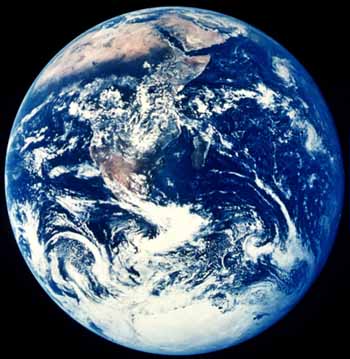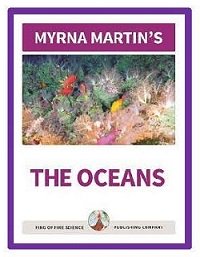Our Blue Planet
The Oceans and seas
The oceans on our planet cover approximately 70% of the Earth. The water that covers our planet is essential to life on our planet. From space the Earth looks like a blue ball partly covered with white wispy clouds. The major oceans from are Pacific Ocean, Atlantic Ocean, Indian Oceans, The Southern Ocean, and the Arctic Oceans
The Southern Ocean is the new name for the ocean that surrounds the continent of Antarctica. It extends to 60 degrees north. The ocean was formerly called the Antarctic Ocean.
Seas are part of the major oceans that are partly surrounded with land. The Mediterranean Sea is an example of a sea that is part of the Atlantic Ocean. It is surrounded by the Mediterranean Basin and is almost completely enclosed by land.

Looking at Planet Earth from space, NOAA
Great Barrier Reef
Astronauts are able to see
the Great Barrier Reef off the coast of Australia from space. This giant
structure was created by animals about the size of a pencil eraser. The Great Barrier Reefs off the coast of Australia are
one of the seven great wonders of the natural world. Today rising ocean temperatures are threatening the reef.
Mid Atlantic Ridge
The Mid-Atlantic Ridge is a divergent plate boundary where continental plates are moving apart down the middle of the Atlantic Ocean. The ridge separates the North American Plate and the Eurasian Plate in the North Atlantic Ocean. Iceland sits on the Mid Atlantic Ridge.
The Mid-Atlantic Ridge in the South Atlantic Ocean separates the Africa Plate and the South American Plate. As the Atlantic Basin in the Atlantic Ocean is increasing in size about 2.3 cm each year. Figure out how much smaller the basin was 1000 years ago. Next figure out how much it will increase in size 10,000 years in the future.
Viperfish
Viperfish are one of the fiercest predators living in the deep ocean. They attract their prey with a “fishing lure” that glows in the dark water. They entice other fish to come close with their glowing fishing lure to impale their prey with fang-like teeth. There are over 5000 species of viperfish that live in the depths of the ocean where it is dark and dangerous because there are no hiding places where they live.
Zones in the Oceans
Oceanographers divide the oceans into oceanic zones. Specialist study animals that live in the different zones. Most ocean life lives in one specific zone. Marine biologists have discovered some animals, whales, can dive to great depths to hunt for food. Female humpback whales are known to dive thousands of feet to look for colossal squid to feed on to provide nutrition for their young.

The Oceans is a fun book to read about the oceans which cover 70% of our planet. Chapters include information on coral reefs, black smokers and the global mid ocean ridge that is the longest mountain range on Earth. Myrna

Click for More Information and to Order
Rift Valleys
Rift valleys run down the ocean floors where crustal plates are separating. They would look like seams on a baseball from space if all the water on our planet suddenly disappeared. Rift valleys are also thinning the crusts of the continents forming rift valleys that may become seas in the distant future.
Rogue Waves
Rogue waves for centuries
were believed to be tall tales sailors told during shore leave. They said waves
rose out of the sea as a vertical wall of water that crashed into a ship
without warning. Today instruments have detected these waves and a Deadliest
Catch film series about catching crabs in Alaska was filmed by a photographer
while filming the series.
Black Smokers
Black smokers (hydrothermal vents) were discovered by scientists aboard the Alvin in 1977. Prior to discovering an entire ecosystem living around the chimneys scientists believed that all living plants and animals needed sunlight to survive. They found that bacteria were able to use sulfides flowing out of the vents to live and they are the base of the food chain in this ecosystem.
KIDS FUN Science Bookstore
Check out Myrna Martin's award winning textbooks, e-books, videos and rock sets. The Kids Fun Science Bookstore covers a wide range of earth science topics. Click here to browse.










